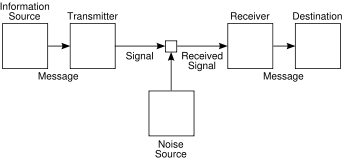- A Mathematical Theory of Communication
-
"A Mathematical Theory of Communication" is an influential[1][2] 1948 article by mathematician Claude E. Shannon. As of August 2011, Google Scholar has listed more than 45,000 unique citations of the article and the later-published book version.
Description
The article was one of the founding works of the field of information theory. Shannon expanded the ideas of this article in a 1949 book with Warren Weaver titled The Mathematical Theory of Communication (ISBN 0-252-72546-8). The book was released as a paperback in 1963 (ISBN 0-252-72548-4). Shannon's article laid out the basic elements of communication:
- An information source that produces a message
- A transmitter that operates on the message to create a signal which can be sent through a channel
- A channel, which is the medium over which the signal, carrying the information that composes the message, is sent
- A receiver, which transforms the signal back into the message intended for delivery
- A destination, which can be a person or a machine, for whom or which the message is intended
It also developed the concepts of information entropy and redundancy, and introduced the term bit as a unit of information.
References
- C.E. Shannon, "A Mathematical Theory of Communication", Bell System Technical Journal, vol. 27, pp. 379–423, 623-656, July, October, 1948
Footnotes
- ^ Robert B. Ash. Information Theory. New York: Interscience, 1965. ISBN 0-470-03445-9. New York: Dover 1990. ISBN 0-486-66521-6, p. v
- ^ Raymond W. Yeung. Information Theory and Network Coding Springer 2008, 2002. ISBN 978-0-387-79233-0, p. 2

This article about a mathematical publication is a stub. You can help Wikipedia by expanding it. This article related to telecommunications is a stub. You can help Wikipedia by expanding it.

